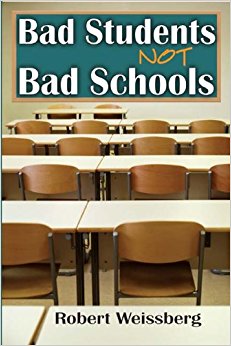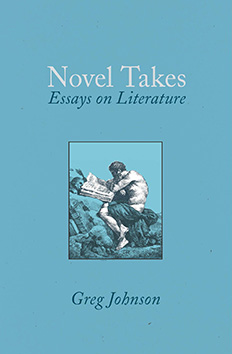A Contrarian View of School Reform
Raymond Wolters, American Renaissance, November 2010
Robert Weissberg, Bad Students, Not Bad Schools, Transaction Publishers, 2010, 315 pp.
Robert Weissberg was born in New York City in 1941. His family was satisfied with the education provided at their neighborhood elementary school on Manhattan’s Upper West Side, but there were problems at the Booker T. Washington Junior High School, which young Robert attended for a few weeks in 1953. This was a decade before many other New York schools “slipped into near disaster,” but when Robert told his parents stories of “mayhem bereft of any learning,” the Weissbergs became early participants in white flight. They moved to suburban New Jersey, whence Robert went on to Bard College, graduate school at the University of Wisconsin, and professorships in political science at Cornell and the University of Illinois.

In 2004, Prof. Weissberg moved back to his home town after 40 years. When he described his experiences at Booker T. Washington to a recent president of that school’s PTA, he learned that conditions had become even worse. And yet, when he met “many of America’s notable educators” — high-ranking public officials, famous writers, noted professors of education, and philanthropists — he found that most were smart and all were serious, but their opinions were “little more than heartfelt clichés.”
In 1953, when Prof. Weissberg had been a student at Booker T. Washington, the school was almost brand new. There was nothing wrong with the teachers, except that they had to spend too much time trying “to control miscreants.” The problem had been the students. Yet when Prof. Weissberg discussed the state of public education with the leading experts half a century later, not one could see that. Some said schools were struggling because of inadequate funds; others found fault with “directive” teaching that did not allow students to achieve deep understanding by “constructing” their own knowledge. Experts from the left and right joined in saying that schools and teachers should be accountable for the scores their students made on standard tests. “The unpleasant possibility that students themselves hated school and their aversion was beyond remediation was . . . unthinkable,” writes Prof. Weissberg, “and voicing it breached decorum.”
In the 1950s and early 1960s, against the backdrop of the Cold War, most public schools emphasized the importance of educating the brightest students. Grouping students by ability came into vogue, and many high schools added advanced placement courses. But the emphasis shifted after the post-Sputnik panic was replaced by concern about civil rights and race riots. Mainstream educators began to focus not on “helping a few Whiz Kids master quantum mechanics so as to protect us from Soviet rockets” but on “moving the entire school population, but especially those at the very bottom, up a few notches.”
The new emphasis was based on egalitarian assumptions. New York Times columnist Deborah Solomon summarized the underlying premise when she said, “Given the opportunity, most people could do most anything.” In a popular textbook, Mary M. Frasier, a professor of educational psychology, affirmed, “There is no logical reason to expect that the number of minority students [in advanced classes] would not be proportional to their representation in the general population.”
Bad Students, Not Bad Schools is a relentless critique of this “educational romanticism.” Prof. Weissberg insists that responsibility for learning should be shifted to students and their families, where most people have always recognized it belonged. With a combination of erudition and wit that are rare in scholarly analyses, Prof. Weissberg says “what everybody (or nearly everybody) knows to be true but is fearful of expressing in public — America’s educational woes just reflect our current demographic mix of students.”
Prof. Weissberg posits a formula in which academic achievement (A) depends on a combination of intelligence (I), motivation (M), resources (R), pedagogy (P) and teaching (T). He recognizes that even smart, motivated students do not learn algebra on their own, so teaching and resources (T and R) are necessary. Yet while acknowledging the importance of resources, pedagogy, and teaching, he maintains that intelligence and motivation matter most.
He writes the formula for academic achievement (A) as follows:
A = 8I × 4M × R × P × T
This is almost like a cooking recipe, with eight portions of intelligence, four portions of motivation, but only one portion of resources, pedagogy, and teaching. Unlike cooking recipes, however, Prof. Weissberg’s formula is not additive but multiplicative. This means that if any term is “0,” the final result is “0,” and if any element is very small, the result will also be small.
The formula stresses “human capital.” Intellectual ability (I) has a huge impact, followed by motivation. Resources, pedagogy, and teaching are essential but less important than intelligence and motivation. The basic problem is that most reformers focus on resources, pedagogy, and teaching. They propose major investments in buildings, new curricula, and better teachers, but they neglect the most important elements: brains and motivation.
To support his formula, Prof. Weissberg cites a number of “natural experiments.” He notes that the United States has recently experienced massive immigration, and most newcomers have settled in low-income neighborhoods with troubled public schools. But he also notes that “student performance in these oft-dreary, run-down sometimes violence-plagued settings varies widely, and these dissimilarities are often so spectacular that the ‘bad school did it’ crime theory utterly collapses.” Hispanics from Mexico and Puerto Rico have done poorly in these schools, but the children of the Vietnamese boat people have excelled. Chinese, Korean, and Russian immigrants have also done well in inner-city schools.
Most school reformers have ignored this. They refuse to concede that “if new students arrive at a ‘bad school’ and excel it is implausible to insist that the school itself inherently destroys learning.” Instead of acknowledging the importance of the students’ intelligence and motivation, the reformers insist that “bad schools are to be cured by more resources, more resources, and yet more resources.”
Integration was another “natural experiment.” Integration was usually a short-lived transitional period between the time when large numbers of blacks moved into a school and the last whites moved out. James S. Coleman, the leading authority on this subject, found that after a tipping point had been reached, an increase of 5 percent in the average white child’s black classmates caused an additional 10 percent of white families to leave. Nevertheless, there were exceptional instances in which racially balanced integration persisted for a generation or more.
When that happened, black students enjoyed “every advantage imaginable in a ‘good school,’ including learning side-by-side with smart white students.” But this did not change academic outcomes. In 2003, after the relation between racial mix and educational achievement had been studied by an army of social scientists, Abigail and Stephan Thernstrom reported that there still was “no scholarly consensus that a school’s racial mix has a clear effect on how much children learn.” The racial gap in achievement persists whatever the racial mix of students.
Prof. Weissberg goes further and contends that integration depressed the achievement of white students. Although test scores and other statistics are not conclusive on this point, there are numerous descriptive accounts of the decline of education in the wake of integration. San Diego, for example, had seven elementary schools, five of which were failing. When students from the five were allowed to transfer to the remaining two, “the influx of refugees . . . outraged parents who paid a housing premium to enroll their offspring in the nearby superior school.” The high-quality schools were “suddenly plagued by physical violence and ‘purple language’ thanks to these new arrivals.” This should not have been a surprise, says Prof. Weissberg. To expect otherwise would have been the equivalent of transferring the sick to a healthy setting and expecting the ill to catch ‘health.’”
In their efforts to “make integration work,” racially balanced schools relaxed standards of decorum, moved away from grouping students by ability, and put more emphasis on remedial education and multiculturalism. Yet more white families fled to private schools and distant suburbs. This is all part of Prof. Weissberg’s chapter on what he calls “the war on academic excellence.” He writes that “the foolishness of the ‘war’ against America’s most talented is almost beyond belief, a relentless pursuit of an egalitarian fantasy at the expense of genuine educational accomplishment.”
School spending provided yet more natural experiments. For several decades the expenditure in most predominantly black inner-city school districts has exceeded the average for their state, and in some areas — Kansas City, Hartford, and the “Abbott districts” in New Jersey, for example — inner-cities schools have swallowed up as much or more money than the states’ wealthiest districts, but with no substantial progress in closing the achievement gap. According to Prof. Weissberg, “beliefs about the power of material resources, versus human capital (i.e., the students themselves) are . . . comparable to insisting that inept basketball teams could become champions if only given better practice facilities or nicer uniforms.”
As Prof. Weissberg explains, race differences in intelligence are the great taboo: “Lying is endemic; explanations of why African-Americans do so poorly can be near mystical.” He adds that “hard-nosed realists” are “shunned or forced into silence,” while “those skilled in manipulating statistics or flattering those desperate to hear good news . . . rise to the top.” He personally thinks that the academic superiority of Caucasians and Asians “is likely to be at least partly genetic,” though he notes that science has not yet defined the boundaries between genetic and environmental effects, and believes further that motivation also matters a great deal.
Because cultural values influence motivation, Prof. Weissberg does not reject the possibility that reform might eventually persuade more students to take school work seriously. However, unlike the schools of yesteryear, which used competition and a variety of punishments to motivate students, the current fashion is to establish a “kinder, gentler educational atmosphere” that encourages achievement by nurturing self-esteem. Prof. Weissberg disdains this “culturally sensitive” approach, which he contrasts with the “old-fashioned methods” that many athletic coaches still use “to instigate high performance from boys, especially black boys.”
Prof. Weissberg also laments that high school students of every ethnicity are influenced by what he calls a “rampant cultural anti-intellectualism.” This is manifest above all in peer pressure that values popularity with the opposite sex and rewards boys who are athletes and girls who are stylish. Prof. Weissberg suggests, however, that in many cases this is a realistic adaptation to reality. Half the white and Asian students in the United States (as well as 85 percent of blacks and 75 percent of the Hispanics) have IQs below 100, so a great many teenagers are not capable of college work, or even of doing what once was required to pass high-school algebra. Students with low IQs eschew study, tutors, and libraries, in large part, to escape the travail of having to deal with material that is beyond their comprehension.
Despite his pessimism, Prof. Weissberg does not despair. If improved academic performance is truly necessary for the United States, a ready solution is at hand: “Just make immigration policy skill driven.” Prof. Weissberg also argues that “most of America’s educational woes would vanish if . . . indifferent, troublesome students” were encouraged to drop out of school “when they had absorbed as much as they were going to learn.” He points out that “dropping out” is nothing new. In the past, many dullards were let go because “nineteenth-century schools were under no pressure to retain malingerers.”
Prof. Weissberg also takes aim at the conventional wisdom that America’s “modern techno-society need[s] ever more well-trained people to survive.” He notes that, “If anything, modern society does not require armies of highly-skilled workers.” “A handful of very smart people may be able to compensate for thousands of dummies, and educating these smart people may be a far better strategy than imploring the latter to shape up.” Prof. Weissberg believes that the money spent on school reform “could be better invested in, say, rebuilding America’s deteriorating infrastructure or some other venture promoting economic growth (and the construction workers could be those unable to get a high school diploma).”
Bad Students, Not Bad Schools conveys much sympathy for weak students and harried teachers. Most students can be taught to read and compute at an elementary level, but Prof. Weissberg believes that “those unable to do college-level math or read complicated material cannot be upgraded by extra attention.” He writes that to require those with low intelligence to “devote untold painful hours to mastering algebra,” is just as foolish as insisting that tone-deaf students learn to sing a cappella.
Prof. Weissberg has little patience, however, for school reformers, who he thinks are just feathering the nest for their own profession. Instead of fostering blue collar jobs in which people of middling intelligence could earn decent wages, reformers squander billions in education-related “make work” for white-collar professionals. After adjusting for inflation, spending per pupil has increased ten times since 1940, and salaries for teachers are just the tip of the iceberg. “Today’s schools overflow with specialized staff catering to the complicated psycho-social needs of pupils who were, allegedly, ignored a generation back.” Prof. Weissberg writes that education has become a stealth anti-poverty program; it is “the New Great Society.”
Prof. Weissberg is especially critical of social scientists. He describes how standardized testing has been manipulated by ruses such as lowering the score required to “pass,” or increasing the number of students who are classified as “disabled” and therefore exempt from testing. He shows how scholars “manufacture reality via including and excluding variables and choosing what to correlate with what.” He says the desire for “good news” about the racial achievement gap has created “a thriving market for mendacity.” Philanthropists “want to hear upbeat news and will happily hire experts who supply it.”
Bad Students, Not Bad Schools is a well-informed and brilliantly perceptive commentary on the recent history of failed educational reforms. It explains why America’s public schools have lurched “from one guaranteed failed reform to the next, squandering hundreds of billions while progress is, we are assured by optimistic politicians, just over the horizon.”















